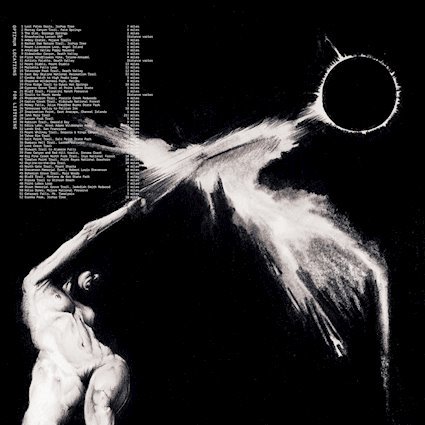In 2015 Ben Chasny of Six Organs of Admittance invented a system (referred to by its adherents simply as THE SYSTEM) for creating and composing music in a new and inventive way. Falling somewhere between the I Ching, a Tarot deck and Brian Eno’s Oblique Strategy cards, THE SYSTEM provides musicians with a way of creating music that falls between composition and improvisation with randomness being a key element. Chasny himself is clearly committed to THE SYSTEM: in the past few years he’s released two very different LPs as Six Organs of Admittance, composed using THE SYSTEM. Taken together they show the flexibility of this method: Hexadic is a loud sprawling thump of electric guitars which has a lot in common with Chasny’s work with Richard Bishop in Rangda; Hexadic II is much more subdued with acoustic guitars and whispered vocals more in the tradition of some of his earlier work as Six Organs of Admittance. Hexadic III is an attempt to push the appeal of THE SYSTEM further: Chasny himself doesn’t feature on any of the tracks, instead he lets a collection of musicians loose on THE SYSTEM and the results are an attempt to demonstrate how it can be relevant and useful for all sorts of musicians, not just him.
The extent to which this project succeeds is debatable. First the good news: the tracks collected here are mostly of a very high quality and they do show each artist clearly able to produce something worthwhile and interesting using THE SYSTEM. However, none of the music on here sounds like anything that could not have been produced without THE SYSTEM: Stephen O’Malley drones, Tashi Dorji scampers up and down the fretboard, Richard Youngs takes a line or two and repeats them until they become all-consuming and hypnotic: they all sound very comfortable and very recognisably themselves. Hexadic III shows that artists working in a wide range of styles and genres can use THE SYSTEM and produce excellent music through doing so, but it doesn’t leave the impression that anything especially new or unexpected has been wrought as a result.
In terms of the quality on display though, the relative brevity of Hexadic III works in its favour. There are only seven tracks and, aside from Tashi Dorji’s contribution (a short solo guitar piece that lacks the bite and playfulness of his recent collaboration with Shane Parish) nothing that feels like filler. Moon Duo do what they do best: lock into a swirling groove so hypnotic that its sudden and abrupt ending crashes you out of orbit with a bump. Richard Youngs also sticks to what he’s good at: settling on a line, “with all of my abandoned problems”, and repeating variations of this until it becomes a towering mantra with layers of significance far above the mundane words themselves.
Hanging over these tracks and other contributions from Jenks Miller, Meg Baird and Charley Saufle is the longest and most imposing track from Stephen O’Malley, Tim Wyskida and Marc Urselli: ‘Solastalgia’. O’Malley is quite possibly the biggest draw on Hexadixc III and it is indeed fascinating to hear him operating in full on doom/drone mode outside of Sunn O))). ‘Solstalgia’ sounds like O’Malley reducing this particular brand of song writing to its absolute essentials. Stripped of Attila Csihar’s theatrical growls, choirs, orchestras and all the other attendant bells and whistles that augmented Sunn O)))’s sound (until Kannon anyway), ‘Solstalgia’ reminds us of how powerful simple instrumental drone can sound in the right hands. Each slab-heavy chord crashes down in exactly the right place (presumably dictated by following THE SYSTEM), with snare rattles or cymbal taps used to provide a sense of seismic aftershocks rather than any attempt at time keeping.
Hexadic III finishes with a solo organ piece from Phil Legarde, a longstanding champion of THE SYSTEM. Legarde’s piece manages again to demonstrate the versatility of THE SYSTEM, which he has adapted from its origin with guitar music for the keyboard. He also manages the difficult trick of following ‘Solstalgia’’s monolithic thirteen minutes and rounding off the collection with something that creates a sense of gravity without attempting to match the heaviness of what went before.
Ultimately, each band or artist on Hexadic III has a unique voice or style: something recognisably theirs that sets them apart from the crowds. What this collection demonstrates is that the Hexadic System can be used by such idiosyncratic musicians without them losing the uniqueness which is a key part of their appeal. Whether these seven artists would have produced equally exciting and interesting contributions without THE SYSTEM is, of course, up for debate.
-
7Pieter J Macmillan's Score






















